Text
IN THE MIDST OF A DISASTERCENE Framing
Ben Robinson x Emir De Jerome x Logan Van Riel
Our journey this semester has brought us together, to raise awareness about the issues that stem from natural disasters and extreme-weather events, in relation to our current management of waste materials and fossil fuels, which could be exacerbating our contributions to the Anthropocene. The Anthropocene, is the proposed current geological age, characterized by human domination of the planetary system (Malhi, 2017). Humans are changing the earth at such an alarming rate, causing mass extinctions of animals and plants. These collective changes have been so enormous and significant, that they warranted their very own epoch, a feat which would have taken millions of years, yet we have managed to accomplish in only a handful of decades. It has meant that the actual physiology of the earth we walk on, has accumulated an unimaginable array of toxic materials, that pose a threat to not just the species we share the planet with, but to our very own food chain. We ask ourselves, is this the legacy we want to leave behind for the future generations? We barely grasp how our own actions are affecting us at present, and frankly, we may never know the extent of our mistakes during our time, but the people who will call this planet home years from now, will have inherited an unprecedented problem: the possibility our own extinction as a species has never been so sobering. Natural disasters disperse devastatingly large quantities of waste materials, often over large distances, and within a very short time period. (Skinner, 2011) They reflect the reality of our own collective habits in their destruction and persistence. We are seeing more and more that, the evidence of the “butterfly effect” in all systems that make up the planet’s biology, and we need to acknowledge our role in the scheme of things and start these conversations, even if they mean conjuring pain and discomfort. Being in New Zealand, we are constantly under threat of earthquakes and cyclones and volcanic eruptions, due to being located in the ring of fire, and surrounded by the southern oceans. The effects of climate change, are especially apparent to us and our neighbors. This is an opportunity to stand-up as world leaders and innovators when it comes to tackling with these issues, that clearly affect all nations equally. One thing is for sure, we cannot solve all these complex problems on our own. We got to this point collectively, so let us help each other through these dark times, as a community. Disastercene was created through a shared vision, Ben played a role in mostly everything, but main tasks were creating the physical landscape and sound editing, as well as managing the team. Logan was in charge of TouchDesigner, our tool of choice for exhibiting the piece, and Emir was in charge of Video Editing. Working with light-based projection-mapping symbolizes our own determination in helping to lead each other out of the darkness.
0 notes
Video
Above and below shows our video projection progress. We now have the majority of our disaster scenarios in place but they all still need a bit of tweaking.
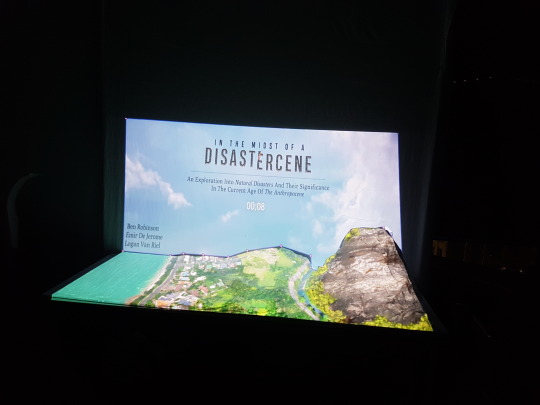
1 note
·
View note
Text
Disastercene - Progress with Projection mapping
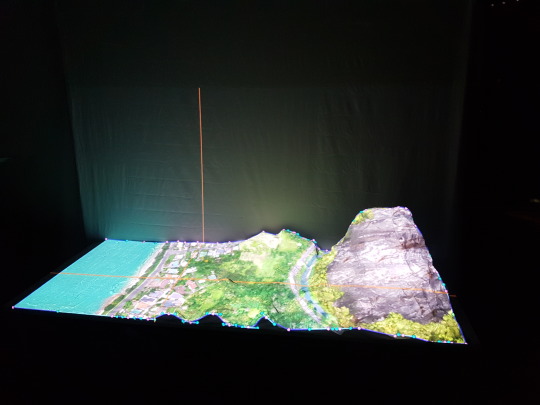
Above shows a big progression for our project. It took me quite a long time to get my head around some of touchdesigners mechanics. I found particularly difficult as it was hard to find tutorials and information online. And when I did find a tutorial it was usually for an older version of the program which was completely different to the program i’m using. So after a lot of trial and error I managed to project a non moving image of how we wanted our terrain to look.
Next step focus on the back wall and change the landscape from an image to a moving video as we want our landscape to look alive
0 notes
Text
Disastercene - Gathering New Zealand Landscape footage field trip
Ben, EJ and myself went on a fun day trip to Thames and some other surrounding areas. Ben luckily has an awesome drone which films in very high quality, and which can travel quite far away from the controller. We gathered footage of a river, roads, beaches, towns and forests.
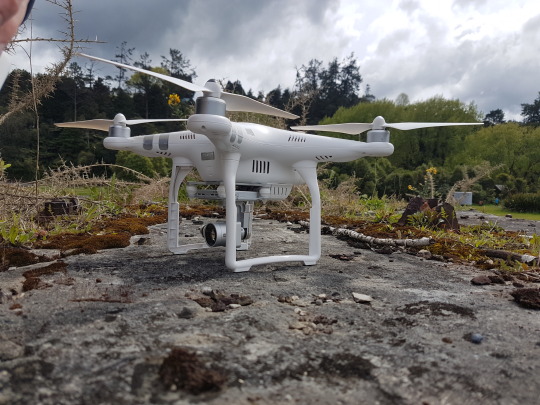

0 notes
Text
Disastercene - Testing projection and designing landscape areas
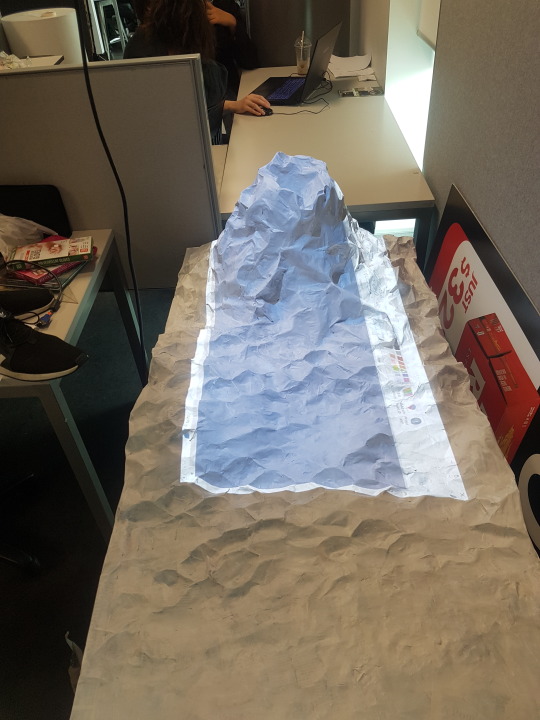
We did some quick tests with a projector to see what the colours look like on our landscape. The colour looks great especially in the darkness. Unfortunately it is hard to find darkness within Studio so I’m going to have to work in studio later in the night so I can work on the projection with clarity.
The photo below shows Where we have placed the projector in relation to our landscape. We placed it so it projects on the landscape as well as a part of the wall behind it.
The photo below also shows how we want to split our landscape up into different areas including ocean/beach, township, forest, rubbish landfill, roads, rivers and a volcano. We did this quick and easily just by using the paint application.

0 notes
Text
Disastercene 3D model of landscape, Touch Designer
It was a great experience to take our physical landscape down to the 3D labs at AUT. The technician at the 3D lab took our landscape for a few days so that he could laser scan our landscape model and render it into 3D model so that we could use it within 3D modeling projects as well as Touch designer which is the program that I will be using to piece our installation together for projection mapping.
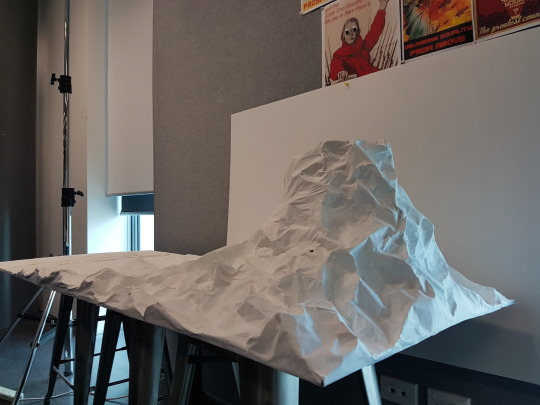

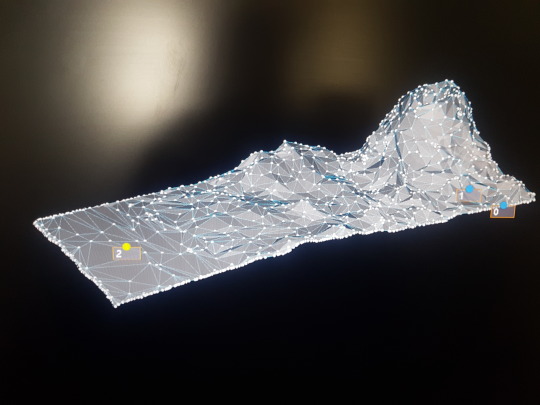
Above and below shows some progress using the program touch designer. I used the function called cam snapper to plot the points on the 3d model of the landscape. Unfortunately I've had a bit of trouble to get it function properly so some research needs to be done.
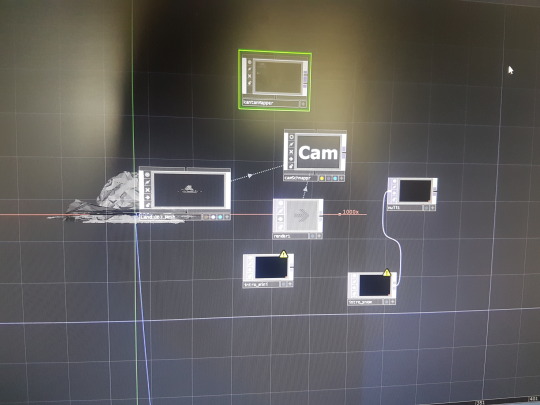
1 note
·
View note
Text
Studio VI Disastercene Landscape
Here are some photos of the progression of construction our landscape for our Disastercene installation. Credit goes to Ben for putting in the hours on constructing our New Zealand inspired landscape.
Below shows Ben constructing the landscape shape with wire and then using paper mache to to create the surface.

After the paper mache was complete, some bandages were stuck on the landscape to give it texture, especially in the ocean part of the landscape. The landscape was then painted white to give the landscape a clean blank canvas appearance.

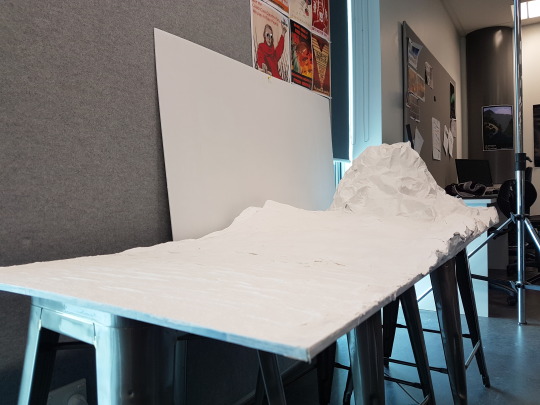
1 note
·
View note
Text
Studio VI - What are we doing
My team including Ben, EJ and myself have decided to work on a project together with the aim of addressing and visualizing the Anthropocene, more specifically to visually show and tell the story of man’s destructively transformational relationship with our environment on earth. For our installation we have planned to physically create a New Zealand like landscape structure out of Paper Mache and Wire. We then plan to use projection mapping on this landscape to then edit a video story line on the landscape. To create this video, we need New Zealand landscape footage (Volcanoes, beaches, forests, towns etc). We will do this with a mixture of captured drone footage and clips pulled from the internet. Once we have all this landscape footage we will create natural disaster scenarios which will transform the landscape and then carry and solidify human produced waste into the Earth, environment and Eco systems. We have decided to name our installation “Disastercene”. This name comes from the mixture of the words Anthropocene and disaster. We have divided tasks and areas to work on between group members. Ben will focus on the construction of the landscape and sound, EJ will focus on video editing, and I will focus on the projection mapping and piecing everything together.
0 notes
Text
Studio VI Anthropocene
The Anthropocene can be said to have begun sometime during the 1800’s during the beginning of the industrial revolution. During this time, humans revolutionized the way we in which we produce, consume and transport. This period of time dramatically increased the material wealth of humanity and has continued to do so until now, the 21st century. These past few hundred years, humans have expanded enormously in the amount of fossil fuels in which we use to fuel our production and transportation. Along with this we have been manufacturing toxic chemical compounds which are then released back into the earth and its atmosphere. We have created chlorofluorocarbon gases which are responsible for the “ozone hole” (Crutzen P.J. 2006). We have now reached a point in the 21st century of no return, where the Earth’s natural cycle cannot compete with Humanity’s destructive forces. In the past few centuries, humans have been rampant with the Earth’s natural resources. We have destroyed millions of hectares of forests from deforestation, emptied a huge percentage of fish from our seas, and also burnt millions of barrels of oil. In today’s age it is astoundingly clear that these unsustainable efforts have had a huge impact on our planet and home. Humans alone have changed the natural cycles on Earth including temperature, weather systems, and eco systems.
Humans are producing millions of tonnes of plastic waste every year which can take thousands of years to degrade away. All this toxic plastic waste can be seen to be changing the earths landscapes and layers. According to geologists from the University of Leicester, plastic has become such a central component of modern life, it has found its way into our Earth's crust itself, becoming a geological marker in recent strata (2016 ,Carrie Poppy). It has been discovered that humans are changing the chemistry within the earth just below our oceanic and Continental crusts. Plastic is being deposited deep within the earth and then mixed with the natural mixing cycle.
Crutzen P.J. (2006) The “Anthropocene”. In: Ehlers E., Krafft T. (eds) Earth System Science in the Anthropocene. Springer, Berlin, Heidelberghttps://www.techtimes.com/articles/128512/20160128/plastic-become-part-earth-geology.htm
(2016 ,Carrie Poppy, Tech Times, Plastic Has Become Part Of Earth’s Geology)
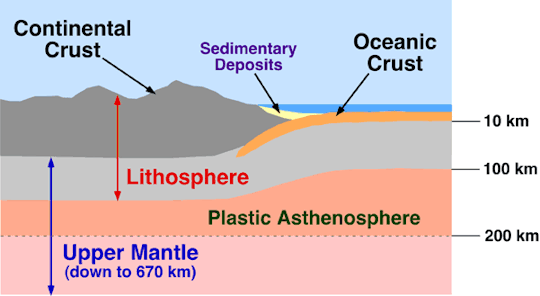
0 notes
Video
Here is our installation finally all set up with our soundtrack playing the background (Thanks to Bruno).

0 notes
Text
SpaceImageSound - Setting up
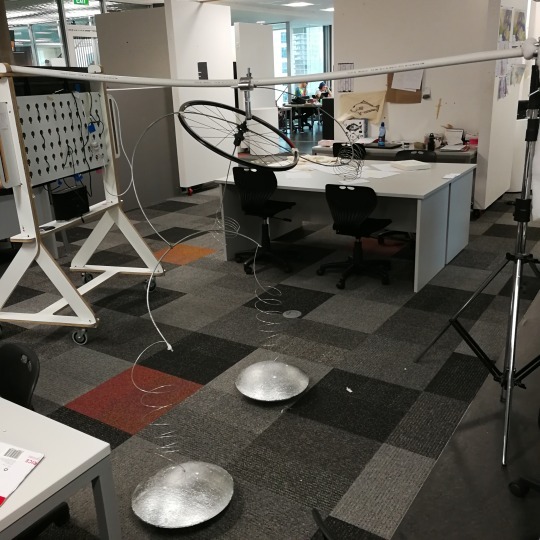
Here is our sculpture after completing all of the metalwork and applying our final coat of metallic paint.We prototyped how it would hang from above in class with a plastic pipe.
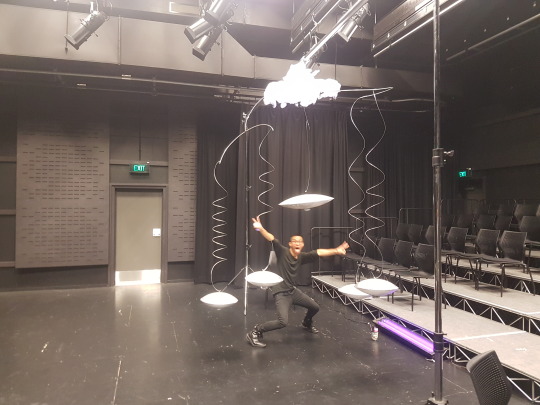
We then moved our sculpture down to the performance labs where we would have enough space to set up our installation. We were able to get two supporting stands which held a metal beam 3 meters high. We clamped our wheel and UFO’s to the beam and then tweaked all of the hanging UFO’s so that they would hang from the right individual heights.
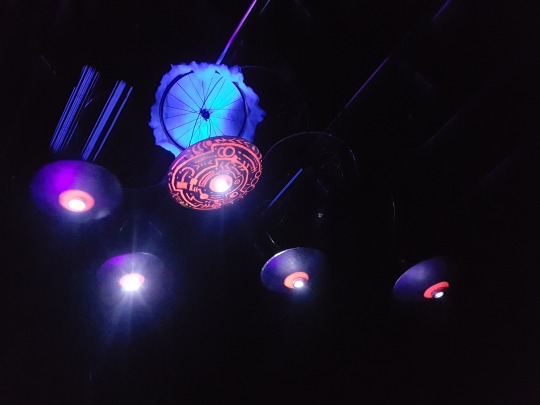
We then did final touches on our sculpture by setting up the lighting which consisted of LED’s and a UV light. We used our UV paint to then paint rings on each of the smaller UFO’s and a design on the Mothership UFO. I was very happy with how they looked in the dark!
0 notes
Text
SpaceImageSound - UFO Baby Mobile - Working with Metal
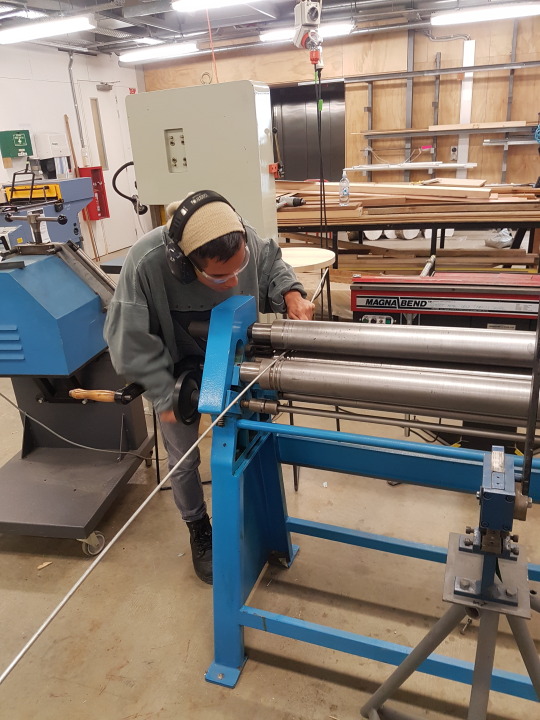
Above is a photo of EJ bending our long metal rod into the S shape which we has intended. This took us a few tries to get the S shape but we got there in the end.
Below shows our bike wheel which will be the main source of movement for our structure. We got a piece of metal welded to the hub of the bike wheel so that it could connect to a clamp which would allow the wheel to hang from above. this photo also shows our S shaped metal rod which will be used to hang our UFO models from.

0 notes
Text
SpaceImageSound - UFO Baby Mobile
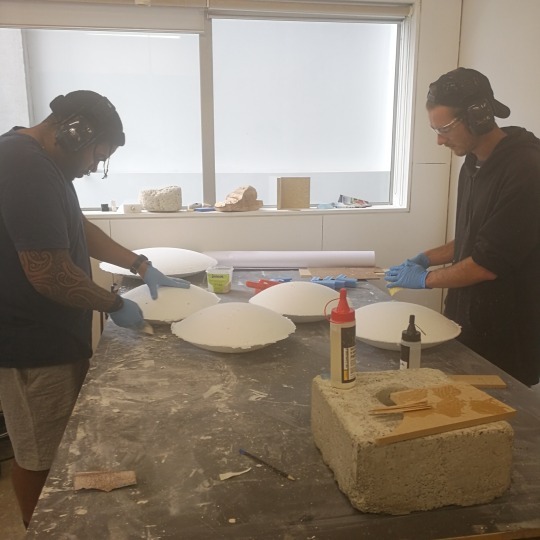
The photos above and below show Bruno, EJ and myself sanding the edges of our freshly cut UFO models. This also shows us gluing the two half's of each UFO together.
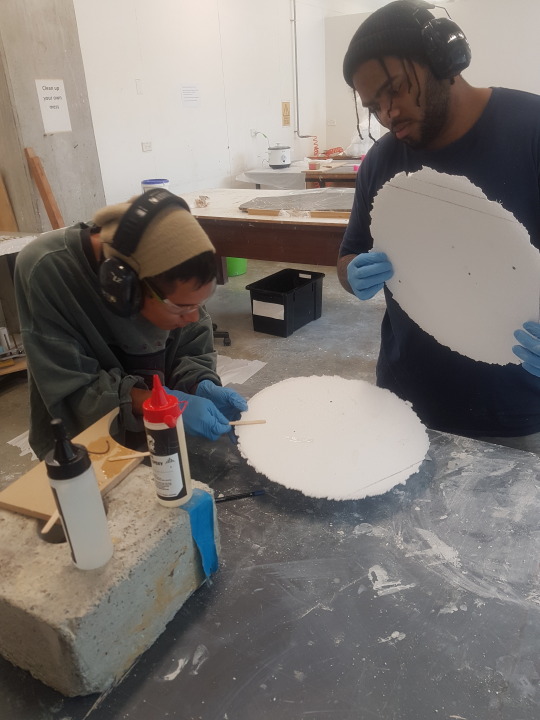
The photo below shows our UFO models after they had been sprayed with primer and painted with multiple layers of acrylic. We ended up using a couple of liters of acrylic which was much more that we had initially planned but it was necessary to fill and natural holes in the polystyrene.

0 notes
Text
SpaceImageSound - Testing
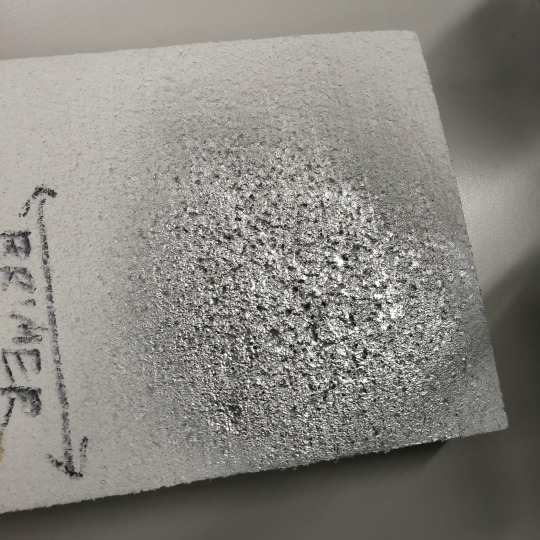
After doing some research into using polystyrene, we realized that we would need to get some decent primer so that our metallic paint would not eat away at our polystyrene. As shown above, extra primer will be needed.
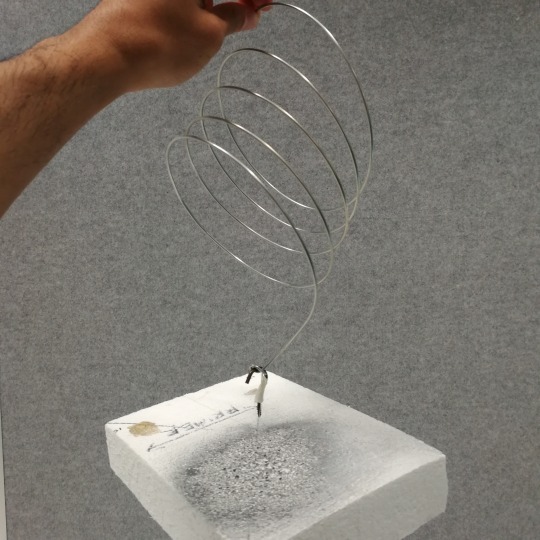
This is our prototype of how the UFO’s will hang from our created mobile structure.
0 notes
Text
SpaceImageSound -UFO Baby mobile
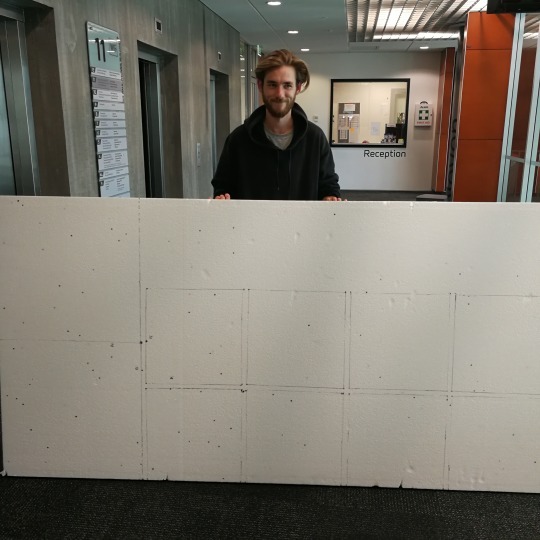
After talking to the technicians in the AUT 3D Labs we decided to make our UFO models out of polystyrene instead of 3d printed plastic. We made this decision as 3d printing is quite expensive and due to the limitations of size when working with 3d printing. By using polystyrene we were able to get our polystyrene cut into the size and shapes which we wanted our UFO’s to be:
4 x 40cm diameter
1 x 60cm diameter
Each UFO was made out of two half's which we then glued together.

Above is a photo of the UFO 3d model. Big thanks to the 3d labs technicians for perfecting it for us.
0 notes
Text
Space image & Sound inspiration
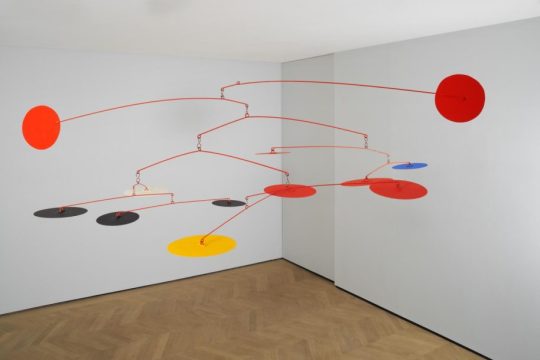
Alexander Calder
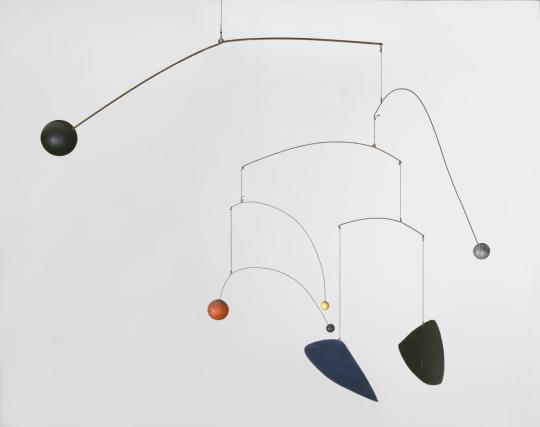
Alexander Calder
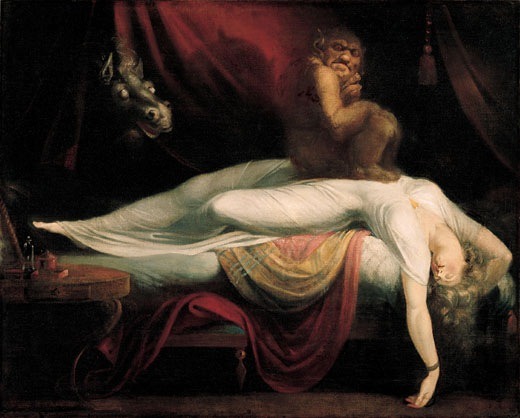
Henry Fuseli, The Nightmare exhibited 1782

Phil Price -Tree of Life, Melbourne, Australia, 2012
youtube
Michael candy - helical kinetic light sculpture
Art in Motion: The Story Behind Mobiles
https://canvas.saatchiart.com/art/art-news/art-in-motion-the-story-behind-mobiles
0 notes
Text
Proposal - UFO Baby Mobile
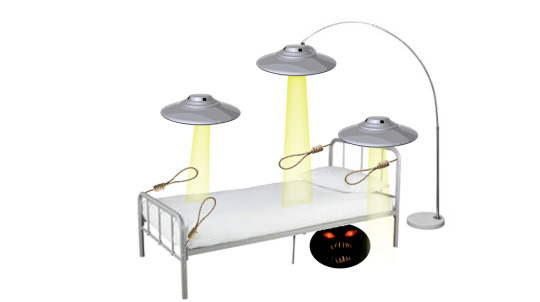
The installation is composed of two main pieces, a single-bed and a “hanging baby mobile”.
The bed and the furnishings on it are white in colour, acting as a canvas for the lighting elements of the installation. It also would have straps that could potentially be used to immobilise the person on the bed. The baby mobile would be made of a shiny, metallic or reflective aluminum material, and appear to be on a larger-scale than the standard baby mobile you would normally have for child cots. The mobile component would be hung from a solid arc-shaped stand.
The audience is invited to lay on the bed, when they look up, the baby mobile they are viewing has elements that resemble UFOs or alien flying saucers. The ensemble would initially spin/rotate on its own but the user can interact further with it by touching or pushing it, harnessing kinetic motion. The mobile would have three UFO pieces. Each UFO or flying saucer would have a light source on the underside, shining down. As the installation moves or gets pushed, the UFO’s create the illusion of those saucers carrying out “abductions” wherever the light shines. The accompanying soundtrack would create an eerie, surrealist atmosphere. It will present itself in “waves”, going between calm and ambient tones, gradually intensifying until it unravels as distorted noise.
There can only be one person on the bed at a time but other people can also observe the experience without lying on the bed.
The whole installation would ideally be placed in an area of a darkened room where people can have enough space to walk around it.
The sound source would come from underneath the bed to give the audience a sense of dimension using distance and how far they are from the installation. It also serves to encapsulate the user lying on the bed, creating an immersive and dream-like environment.
Methods/Tools:
Blender, Unity, Fusion 360 will be used for 3D modeling for prototypes and 3D-printed scale models to test the kinetic components.
We are also looking at employing laser-cutting and carpentry to build the “flying saucer” components.
Audition, Logic Pro X: To be used for audio editing and composition of our soundtrack.
Materials:
For now we are going to be using the following materials.
Metal Bed-Frame, Wood, Bed-Sheets, Pillows, Mattress, Metallic Paint, Aluminium, Lights, Rope, Speakers, Nylon, String, Cutters, Tape, Lights.
Conceptual Statement
UFO Baby Mobile is an installation piece that plays upon our collective fears and dreams.
The whites of the bed and its furnishings represents a kind of “blankness” akin to a canvas. It could be a form of sanctuary, or a place of recluse, somewhere we could escape to and express our vulnerability. It could also be seen as a site of despair, a prison, or a play on the idea of the “death-bed”. It plays into the notion of the commonality of sleep between all of us, and our relationship with the act of sleeping and dreams. Dreams are often unclear and confusing but they stem from something embedded deep within our consciousness. There is a reference to the work ‘My Bed’ by Tracey Emin.
The UFOs or Flying Saucers, represents the future, something unknowable but inevitable. It could be a symbol for where our society is headed in terms of modernisation and the advancements we have made in technology, as well as how far we’ve come with space-age exploration and the potential consequences that it presents for us as a society. It forewarns us of speculative futurist scenarios, such as interspecies breeding with extra-terrestrial lifeforms. Thus embarking on a dialogue, about the future or continuation of the human race. It relates to our apprehensions around kidnappings or abductions as well as xenophobia.
The way sound is presented in the installation, plays on the idea of night-terrors or sleep-paralysis. The soundtrack evokes emotions that follow the pattern of a wave, going between a sense of ambient calm building up into a crescendo of unease and fear using distorted noise. These wave patterns are in parallel with nightmares and how they often bend from subtle absurdity before spiraling out of control.
The ropes on the corners of the bed, create an opportunity for an interaction between the person lying down and the observers around them, wherein they could choose to engage in bondage, manipulating the aspect of control within the piece. This would give the person lying down a lucid experience of entrapment or further playing into the idea of sleep-paralysis.
The baby mobile relates back to childhood innocence, and the stories we were told by our parents, how those dark tales were used to in-still fear, in order to teach us certain values and ideologies, and the enforcement of behaviours. Parents generally used baby-mobiles as a form of distraction in their child-rearing. It enables them to leave the child within the cot, and in that sense, becoming a form of control.
‘UFO Baby Mobile’ invites us to challenge our perceptions on control or our lack of it, reproduction and desire, and what exists beyond the current human state as well as how much value we place on life when we are faced with potentially daunting or unfamiliar circumstances.
References
Gabriel, T. (1996, September 12). Alien Beings Abduct Pop Culture. The New York Times. Retrieved from https://www.nytimes.com/1996/09/12/garden/alien-beings-abduct-pop-culture.html
Cheyne, J. A. (2003). Sleep Paralysis and the Structure of Waking-Nightmare Hallucinations. Dreaming, 13(3), 163–179.
Tate. (n.d.). Gothic Nightmares: Fuseli, Blake and the Romantic Imagination: Room 1. Retrieved August 29, 2018, from https://www.tate.org.uk/whats-on/tate-britain/exhibition/gothic-nightmares-fuseli-blake-and-romantic-imagination/gothic
Tree of Life | Phil Price Kinetic Sculpture. (n.d.). Retrieved August 29, 2018, from https://philpricesculpture.com/project/tree-of-life/
Michael candy handcrafts helical kinetic light sculpture. (n.d.). Retrieved August 29, 2018, from https://www.designboom.com/art/michael-candy-big-dipper-kinetic-light-sculpture-08-07-2014
Worry in children is related to perceived parental rearing and attachment - ScienceDirect. (n.d.).
Westrum, R. (1977). Social Intelligence About Anomalies: The Case of UFOs. Social Studies of Science, 7(3), 271–302.
Art News: Art in Motion: The Story Behind Mobiles. (n.d.). Retrieved August 29, 2018, from https://canvas.saatchiart.com/art/art-news/art-in-motion-the-story-behind-mobiles
artnet. (n.d.). Works of Calder. Retrieved from https://www.youtube.com/watch?v=QSF9C2AuIJM
https://www.theguardian.com/artanddesign/2017/oct/27/tracey-emin-my-bed-violent-mess-sex-death
2 notes
·
View notes